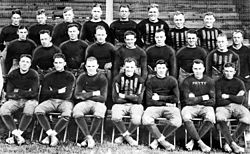This article needs additional citations for verification .(October 2018) |

 | |
| Location | 521 North 7th (now 22nd) Street Decatur, Illinois, United States |
|---|---|
| Coordinates | 39°50′48″N88°55′35″W / 39.84667°N 88.92639°W |
| Owner | A. E. Staley Company |
| Capacity | 1,500 |
| Surface | Grass |
| Tenants | |
| Decatur Staleys (APFA) (1920) Decatur Commodores (IIIL) (1901–1915) | |
Staley Field in Decatur, Illinois, United States, was the home of the Decatur Staleys club of the American Professional Football Association in 1920, coached and managed by the young George Halas, who also played for the team.
Contents

The team was owned by the A. E. Staley Manufacturing Company, for which Staley Field was the company athletic field. [1]
Staley Field was also used by the company baseball team during the summer months, and Halas also played on that team. The field was also used by the Decatur entry in the Three-I League in 1915 and 1922–23. [2]
Although the Staley football team was popular in 1920, it struggled financially, partly due to Staley Field's 1,500 seating capacity. Fans were charged $1 to attend games and company employees received a 50 percent discount, which was not economically feasible for the Staleys and prompted Halas to move games to Cubs Park (now Wrigley Field) in Chicago. [3]
The Staley company sold the team to Halas and his partners, who transferred the team to Cubs Park in 1921. As part of the deal, they operated under the "Staley" name for one more season. They proceeded to win the APFA championship that season. For 1922, they renamed themselves the Chicago Bears in order to associate themselves with their landlords. [4]
